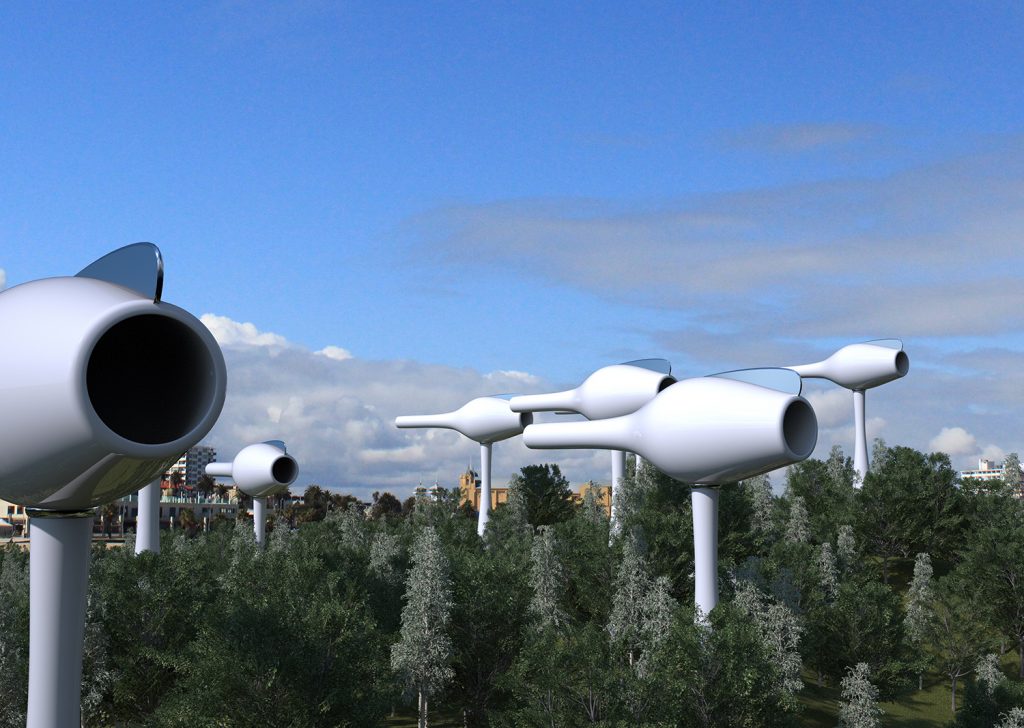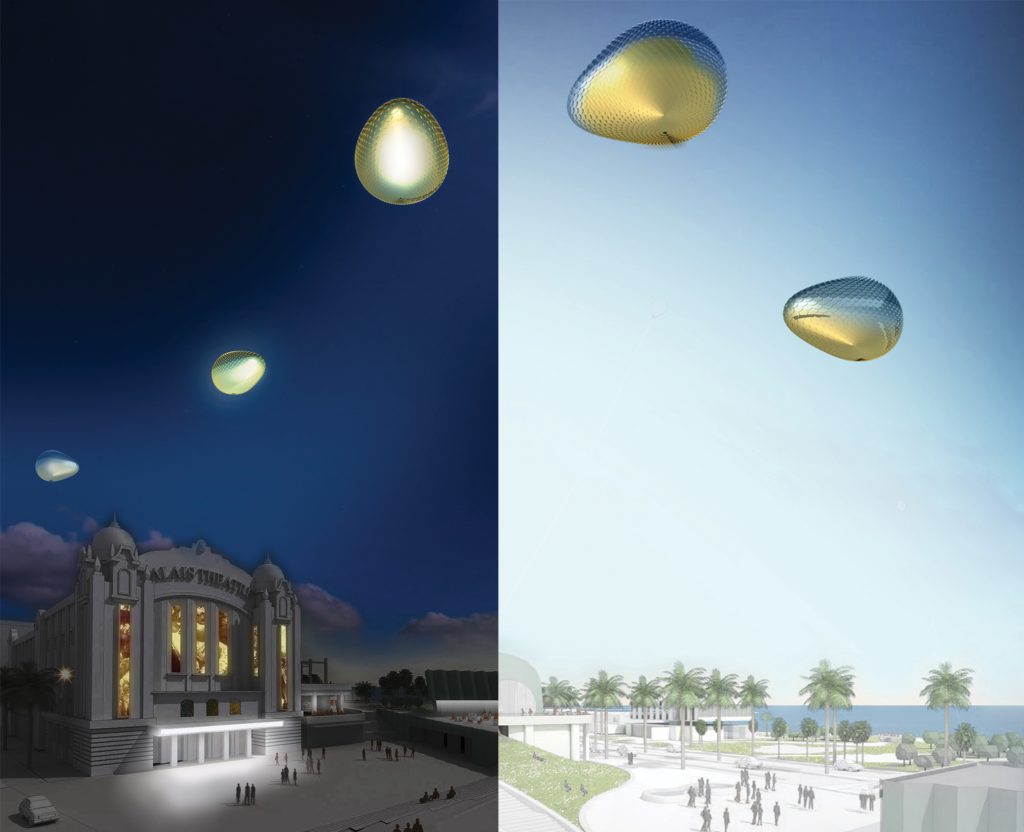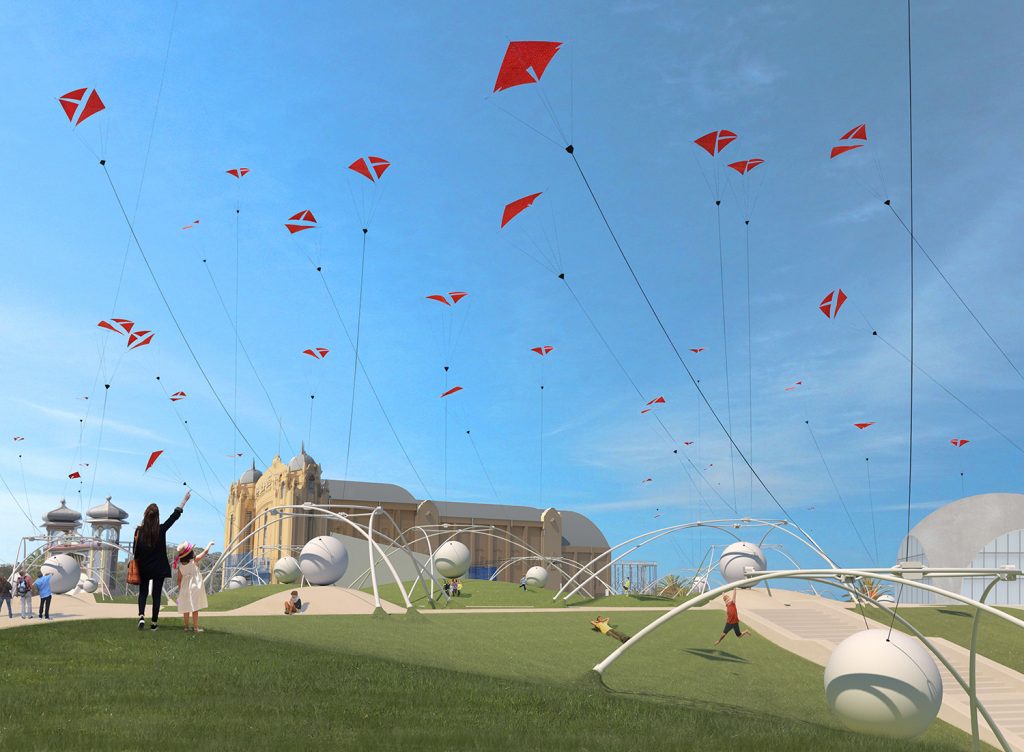Asked about wind-harvesting technology, most people probably think of giant turbines dotting any given landscape. But today, there are many more ways to capture this abundant natural resource.
The four submissions to the 2018 Land Art Generator design competition for Melbourne highlighted below demonstrate exciting advances in wind energy technology taking place behind the scenes and how these innovations can be incorporated into public artwork. Each of these designs for St Kilda Triangle in the City of Port Phillip is both beautiful and functional, providing stellar models for urban generation in the post-carbon era.
Seaflute

Artist Team: Iman Khalili, Aziz Khalili, Puya Khalili, Laleh Javaheri
Energy Technologies: direct wind to electricity generator (D-WEG)
Annual Capacity: 1,200 MWh
A submission to the 2018 Land Art Generator design competition for Melbourne
Aziz Khalili, with help from sons Iman and Puya with Ionics Research + BETTER in Canada, designed a bottle-shaped device that uses Direct Wind to Electricity Generator (D-WEG) technology to convert wind energy into electricity. No moving parts. Minimal energy loss. Wind enters the narrow opening, creating a vacuum at the back that sucks out interior air. More air then rushes in to fill up this space, creating a constant, forceful flow of air from the design’s opening to the back. When that air passes through Seaflute’s narrow neck, which is equipped with an Electrostatic Ion Generator, it creates a long stream of charged electrons that then encounter the module’s Ferromagnetic core. This uses induction to generate an ongoing electrical current that is captured, regulated, and sent directly as a DC current to lithium batteries for storage. It also acts a programmable flute that plays music.
Balo-on

Artist Team: Martin Mráz, Camila Rodriguez León
Energy Technologies: high altitude wind power (buoyant aerostat), organic photovoltaic (OPV)
Annual Capacity: 50 MWh
A submission to the 2018 Land Art Generator competition for Melbourne
Balo-on is a buoyant airborne turbine (BAT) with a horizontal axis wind turbine within its shell. Pioneered by the Massachusetts Institute of Technology and Altaeros, this technology harnesses the abundant energy in strong, steady winds at higher altitudes of up to 600 meters. The aerostat is aerodynamically shaped so that wind generates lift that helps maintain altitude and buoyancy. Each balloon is covered in a bright and reflective lacquered golden fabric to deter collisions with birds. Adding to its energy-generating capacity are organic photovoltaic cells (OPV) installed on the exterior, a hybrid technology designed to make the most of Melbourne’s unpredictable weather patterns.
UNWIND

Artist Team: David Donley, Michael Cinalli
Energy Technologies: high altitude wind turbine
(kite HAWT)
Annual Capacity: 1,900 MWh
A submission to the 2018 Land Art Generator design competition for Melbourne.
Playing with kites can be fun and regenerative! Kite power is twice as efficient as existing wind energy technology because they can reach higher atmospheric winds that are both more consistent and more powerful than winds closer to the ground. Each unit in UNWIND operates on a system of two kites—connected to a giant ball—that cycle in a yo-yo style. While one kite flies up in a figure eight pattern, the second is retracted. When the first reaches its max height and readies to return, the second begins its ascent. Inside the spheres are two spools connected to ratcheted gears that engage the momentum flywheel, regulating the speed of the unspooling kites. This output rotational energy is connected to a generator that produces electricity for St Kilda. At night, the installation transforms into something else entirely. Placed underneath each sphere’s translucent fiberglass shell is an LED mesh that can be programmed to glow in different hues or to produce images or text, making learning about renewables an enjoyable, inspiring experience.
Wind Blossom

Artist Team: Joo Hyung Oh, Jae Ho Yoon
Energy Technologies: pico wind turbines, energy-generating pavers
Annual Capacity: 960 MWh
A submission to the 2018 Land Art Generator design competition for Melbourne.
Exemplifying the opposite end of the turbine spectrum, in terms of size, we have this wonderful design from South Korea. Joo Hyung Oh and Jae Ho Yoon envision a series of undulating landforms that enhance views to Port Phillip Bay. Carved into the green hills are 23 tunnels strategically oriented to capture two major wind currents, including northerly winds along the Esplanade and Jacka Boulevard, and another wind stream rising from St Kilda Beach. Inside the tunnels are thousands of tiny pico turbines, which are are more efficient at harvesting wind energy than larger turbines, according to the design team. Combined with Pavegen pavers placed throughout the site, the mini turbines are capable of powering around 200 Australian homes each year.